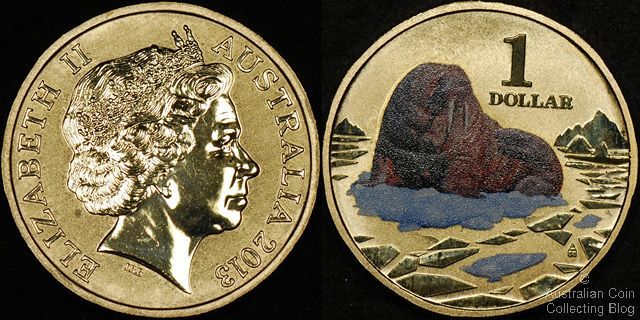
Australia 2013 Walrus Coloured 1 Dollar
The Walrus is another coloured dollar coin in the Royal Australian Mint's 6 coin Polar Animals series. It was issued in the second release of 2 coins in May 2013.
Close your eyes and picture a Walrus - what do you see? A big, bulky animal with tusks, lying around on the ice all day, lots of noise, fighting and jostling. Anything else comes to mind?
Nothing? OK, let's give you some more information.
You might be interested to know that the plural of walrus is walruses.
Both male AND female walrus have downward-pointing tusks, made of ivory. The tusks can grow up to 1 metre in length and are used to smash through the ice to gain access to the sea and for hauling themselves out of the water or across the ice (referred to as "tooth walking"). The tusks also provide a fulcrum for breathing. The walrus hangs vertically from a hole in the ice, with it's snout just above the water line, positioning it's tusks across the ice to take it's body weight.
As their tusks have growth rings, they can be aged using the same method for aging trees.
The tusk also distinguishes rank - the longer the tusk, the more prominent and important the walrus is in it's community.
The walrus can turn it's flippers forward, allowing it to move easily across the ice. Each flipper has 5 digits.
The Walrus doesn't have ears.
When they need to feed, they dive to great depths to the ocean bed - using their tusks to rake through the ocean bed sediment and then using their whiskers to locate clams, mussels, snails, crabs, shrimp, worms and other ocean floor organisms. They also blow to move the shellfish out of the sediment. When there's a lack of shellfish, Walrus have been known to feed on young seal carcasses.
Walruses have a very low reproductive rate with females giving birth to 1 calf almost every two years. The gestation period is from 15 to 16 months, with calves weighing up to 75kg at birth. Calves are weaned from their mothers after a year, and will spend up to 5 years with their mothers.
The Killer Whale and Polar Bear (depicted on another coin in this series) are the Walruses natural predators. Man too has played a huge part in being a significant threat in taking this species to the edge of extinction, through commercial hunting for their tusks, oil, skin and meat. Thankfully commercial hunting is now banned, with only Native Americans being allowed to "culturally" hunt, allowing the Walrus population to recover their numbers.
Global warming, is also playing it's part in threatening the Walrus. As the earth becomes warmer, the ice pack is reducing in size. Smaller ice packs means Walruses can't live near their optimal feeding grounds. Calves are then left on their own for longer and longer periods, suffering nutritional stress. As Walrus communities are spending less time with one another because of the distances traveled to feed, lower reproductive rates are being recorded. Smaller ice packs also means there's less real estate to haul out onto - stampeding deaths from overcrowding have been reported.
The Walrus coin is a standard 9 gram 25 millimetre one dollar coin. The reverse frosted uncirculated finish is a Walrus design by Aaron Baggio, with the obverse portrait of Queen Elizabeth II by Ian Rank-Broadley. This coin is one of six coins in this series -others depict the Polar Bear, Rockhopper Penguin, Atlantic Puffin, Weddell Seal and the Humpback Whale. The Polar Animals series follows the successful Animals of the Zoo Series of 2012 and the Air, Land and Ocean series of previous years.
The Walrus coin is issued at $15 and is presented in a colourful collector's card. Mintage is unlimited at this time and will be determined by collector demand. See the 2013 1 dollar coin mintages table for the most up to date mintage information.
Posted by harrisk at August 22, 2013 1:00 PM
Subscribe to our Newsletter


